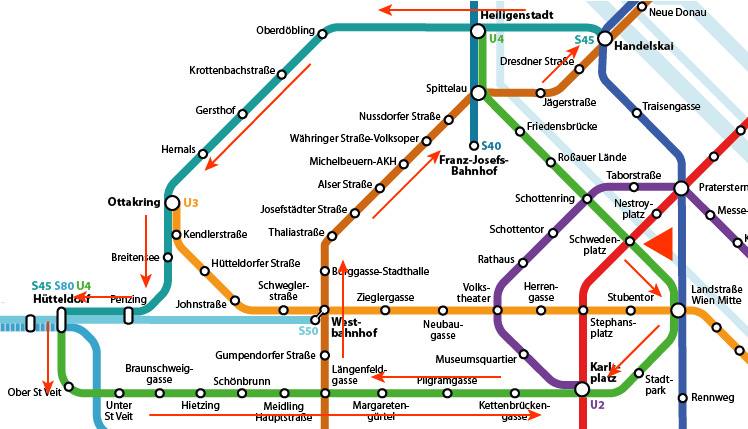A tour of the historical metro lines
If you ever come to Vienna and are interested in Art Nouveau railway architecture, you should try a ride along one of the most interesting urban railways - the remnants of Otto Wagner's Stadtbahn, built in 1893-1901, and now incorporated into Vienna's metro and S-Bahn system. Wagner conceived the Stadtbahn as a kind of Gesamtkunstwerk, designing pretty much everything in the process - buildings, bridges, railings, lighting, and apparently even the original coaches.
All you need is a ticket (a 24-hr pass is advisable, otherwise you may need up to 4 single tickets) and 90-120 minutes, depending on whether you want to stay on the train or take a closer look at some stations.
Caveat: you should consider doing this between 10 am and 2 pm or on a Saturday or Sunday, as line U6 can be terribly crowded during peak hours.
This map will guide you:

You start at Schwedenplatz station. Follow the signs to line U4 and take a train to Hütteldorf. At Schwedenplatz, nothing is in any way reminiscent of the historical station, but as soon as the train leaves the station, you get a look at the Danube Canal, and briefly afterwards, the train crosses the Wien river on a steel bridge. Above this bridge is a footbridge, also designed by Otto Wagner, which featured in the movie Before Sunrise.
Briefly afterwards, you arrive at Stadtpark station, the only underground station still largely in its original state (a second exit was added in the late 1990s, but otherwise it looks almost exactly as it did in 1899).
The line now runs above surface along the Wien river. Get off at Längenfeldgasse. This is a new station built in the 1980s. You'll have to change platforms there (go upstairs through the ticket hall and downstairs to the other platform). While you're doing this, have a quick look towards Otto Wagner's bridge over the Wienzeile. It is to the east of the station, with rail tracks rising towards it.
Now get on a train of line U6 to Floridsdorf. The train will climb up towards the bridge and then pass through a number of stations built by Otto Wagner, most of which have been well preserved, such as Gumpendorfer Strasse, Burggasse or Alser Strasse. Next to Michelbeuern station is the original Stadtbahn depôt, also designed by Wagner, which has, of course, since been significantly extended and modernised.
The last of the Wagner stations is Nussdorfer Strasse, but stay on the train, which will go into tunnel again, and get off when it resurfaces at Handelskai. Walk down the stairs to the platform of line S45. It is the terminus of the line, so you don't have to worry about directions. Unfortunately there's not much to see here, except of course the Danube.
The interesting part starts when the train has passed through Heiligenstadt. The stations at Gersthof, Hernals and Ottakring are fine examples of Wagner's railway architecture. If you're already bored by the time you reach Ottakring, you can get off here and take line U3 back to the city centre. Otherwise stay on the train and enjoy the ride until the train terminates at Hütteldorf.
There, change to line U4. Unfortunately most stations here have been refurbished beyond recognition on the platform level (some of Wagner's buildings on the street level have survived). At Hietzing, you can have a look at the Imperial Pavillon, a station built by Wagner for Emperor Franz Joseph, but sadly never used by the emperor. The station at Schönbrunn, being a listed building, had survived 1970s refurbishment, but the recent installation of a new lift has changed it almost beyond recognition.
Continue the trip until you reach Karlsplatz. Take the exit to Resselpark, and as soon as you are up the stairs, turn right and climb the stairs to the street surface. You will emerge through the back of one of Otto Wagner's famous Art Nouveau pavilions. Of course in the past, passengers used to emerge through the front doors, but these days, the pavilions are used as a café and a museum. Here you can have a coffee or learn more about the architect Otto Wagner.
Enjoy the ride!